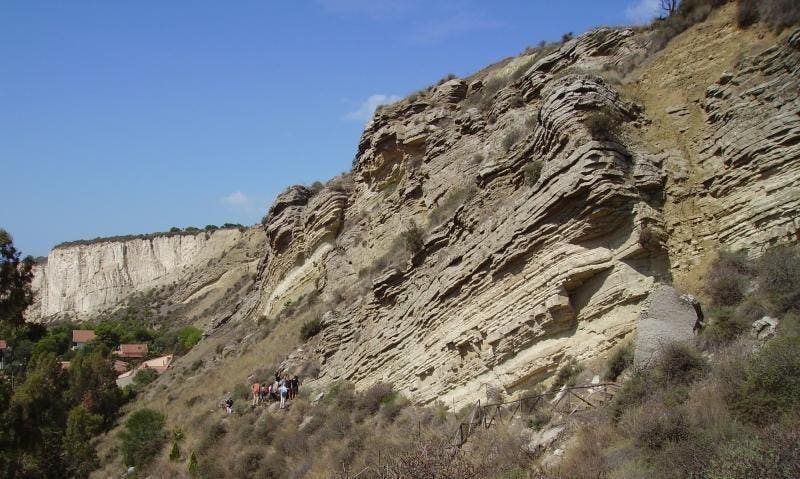Outcrops with thick salt deposits in Sicily.
While wandering along the cliffs of the Mediterranean Sea — particularly in southern Italy and Sicily — one might come across outcrops composed entirely of thick layers of salt and gypsum.
Thanks to geophysical surveys and an extensive drilling campaign conducted during the Glomar Challenger expedition, we now know that these salt layers extend beneath the Mediterranean Sea and, in some regions, reach thicknesses of up to 2.5 kilometers. Such deposits can only form by evaporating large amounts of seawater. For almost 200 years scientists wondered how this was possible, and one unique salt lake — the Dead Sea in Israel — may provide an answer.
“These large deposits in the earth’s crust can be many, many kilometers horizontally, and they can be more than a kilometer thick in the vertical direction,” says UC Santa Barbara mechanical engineering professor Eckart Meiburg, lead author of a new study. “How were they generated? The Dead Sea is really the only place in the world where we can study the mechanism of these things today.”
Salinity levels in the Dead Sea are famously so high that only few organisms can survive in its waters, giving it its name.
Indeed, while there are other bodies of water in the world with high salinity levels, only in the Dead Sea they form massive salt deposits, which allows researchers to tackle the physical processes behind their evolution, and in particular, the spatial and temporal variations in their thickness.
In their study, Meiburg and fellow author Nadav Lensky of the Geological Survey of Israel cover the fluid dynamics and associated sediment transport processes currently governing the Dead Sea.
In 2019, the researchers observed a rather unique process occurring in the lake during the summer. While evaporation was increasing the salinity of the water on the surface, salts washed into the lake were nonetheless continuing to dissolve due to its warmer temperature. When the dense, salt-rich water sinks to the ground, it mixes with cooler water rising upwards. At the interface between the two layers, halite (common salt) crystals start to grow. The heavy crystals fall to the bottom, forming a sort of “salt snow” covering the bottom of the Dead Sea basin.
Detail of the outcrop showing single salt and gypsum crystals.
In contrast to shallower hypersaline bodies in which precipitation and deposition occur during the dry season, in the Dead Sea salt formation occurs during the entire year.
In addition to other factors including internal currents and surface waves, this process is highly effective in creating salt deposits of various shapes and sizes, the authors conclude.
About 5.96 to 5.33 million years ago tectonic forces closed off the Strait of Gibraltar, reducing the inflow from the Atlantic into the Mediterranean basin and creating conditions similar to the Dead Sea basin — but on a vastly larger scale.
“The sea level dropped 3 to 5 kilometers (2-3 miles) due to evaporation, creating the same conditions currently found in the Dead Sea and leaving behind the thickest of this salt crust that can still be found buried below the deep sections of the Mediterranean,” Meiburg explains.
“But then a few million years later the Strait of Gibraltar opened up again, and so you had inflow coming in from the North Atlantic and the Mediterranean filled up again.”
The full study, “Fluid Mechanics of the Dead Sea,” was published in the journal Annual Review of Fluid Mechanics and can be found online here.
Additional material and interviews provided by University of California – Santa Barbara.









